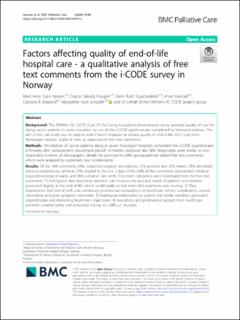| dc.contributor.author | Hansen, Marit Irene Tuen | |
| dc.contributor.author | Haugen, Dagny Faksvåg | |
| dc.contributor.author | Sigurdardottir, Katrin Rut | |
| dc.contributor.author | Kvikstad, Anne | |
| dc.contributor.author | Mayland, Catriona Rachel | |
| dc.contributor.author | Schaufel, Margrethe Aase | |
| dc.date.accessioned | 2020-09-04T11:06:47Z | |
| dc.date.available | 2020-09-04T11:06:47Z | |
| dc.date.created | 2020-07-17T13:33:12Z | |
| dc.date.issued | 2020 | |
| dc.identifier.issn | 1472-684X | |
| dc.identifier.uri | https://hdl.handle.net/11250/2676414 | |
| dc.description.abstract | Background
The ERANet-LAC CODE (Care Of the Dying Evaluation) international survey assessed quality of care for dying cancer patients in seven countries, by use of the i-CODE questionnaire completed by bereaved relatives. The aim of this sub study was to explore which factors improve or reduce quality of end-of-life (EOL) care from Norwegian relatives’ point of view, as expressed in free text comments.
Methods
194 relatives of cancer patients dying in seven Norwegian hospitals completed the i-CODE questionnaire 6–8 weeks after bereavement; recruitment period 14 months; response rate 58%. Responders were similar to non-responders in terms of demographic details.104 participants (58% spouse/partner) added free text comments, which were analyzed by systematic text condensation.
Results
Of the 104 comments, 45% contained negative descriptions, 27% positive and 23% mixed. 78% described previous experiences, whereas 22% alluded to the last 2 days of life. 64% of the comments represented medical/surgical/oncological wards and 36% palliative care units. Four main categories were developed from the free text comments: 1) Participants described how attentive care towards the practical needs of patients and relatives promoted dignity at the end of life, which could easily be lost when this awareness was missing. 2) They experienced that lack of staff, care continuity, professional competence or healthcare service coordination caused uncertainty and poor symptom alleviation. 3) Inadequate information to patient and family members generated unpredictable and distressing final illness trajectories. 4) Availability and professional support from healthcare providers created safety and enhanced coping in a difficult situation.
Conclusions
Our findings suggest that hospitals caring for cancer patients at the end of life and their relatives, should systematically identify and attend to practical needs, as well as address important organizational issues. Education of staff members ought to emphasize how professional conduct and communication fundamentally affect patient care and relatives’ coping. | en_US |
| dc.language.iso | eng | en_US |
| dc.publisher | BMC (part of Springer Nature) | en_US |
| dc.rights | Navngivelse 4.0 Internasjonal | * |
| dc.rights.uri | http://creativecommons.org/licenses/by/4.0/deed.no | * |
| dc.title | Factors affecting quality of end-of-life hospital care - a qualitative analysis of free text comments from the i-CODE survey in Norway | en_US |
| dc.type | Peer reviewed | en_US |
| dc.type | Journal article | en_US |
| dc.description.version | publishedVersion | en_US |
| dc.source.journal | BMC Palliative Care | en_US |
| dc.identifier.doi | 10.1186/s12904-020-00609-x. | |
| dc.identifier.cristin | 1819720 | |
| dc.description.localcode | © The Author(s). 2020 Open Access This article is licensed under a Creative Commons Attribution 4.0 International License, which permits use, sharing, adaptation, distribution and reproduction in any medium or format, as long as you give appropriate credit to the original author(s) and the source, provide a link to the Creative Commons licence, and indicate if changes were made. The images or other third party material in this article are included in the article's Creative Commons licence, unless indicated otherwise in a credit line to the material. If material is not included in the article's Creative Commons licence and your intended use is not permitted by statutory regulation or exceeds the permitted use, you will need to obtain permission directly from the copyright holder. To view a copy of this licence, visit http://creativecommons.org/licenses/by/4.0/. The Creative Commons Public Domain Dedication waiver (http://creativecommons.org/publicdomain/zero/1.0/) applies to the data made available in this article, unless otherwise stated in a credit line to the data | en_US |
| cristin.ispublished | true | |
| cristin.fulltext | original | |
| cristin.qualitycode | 1 | |

